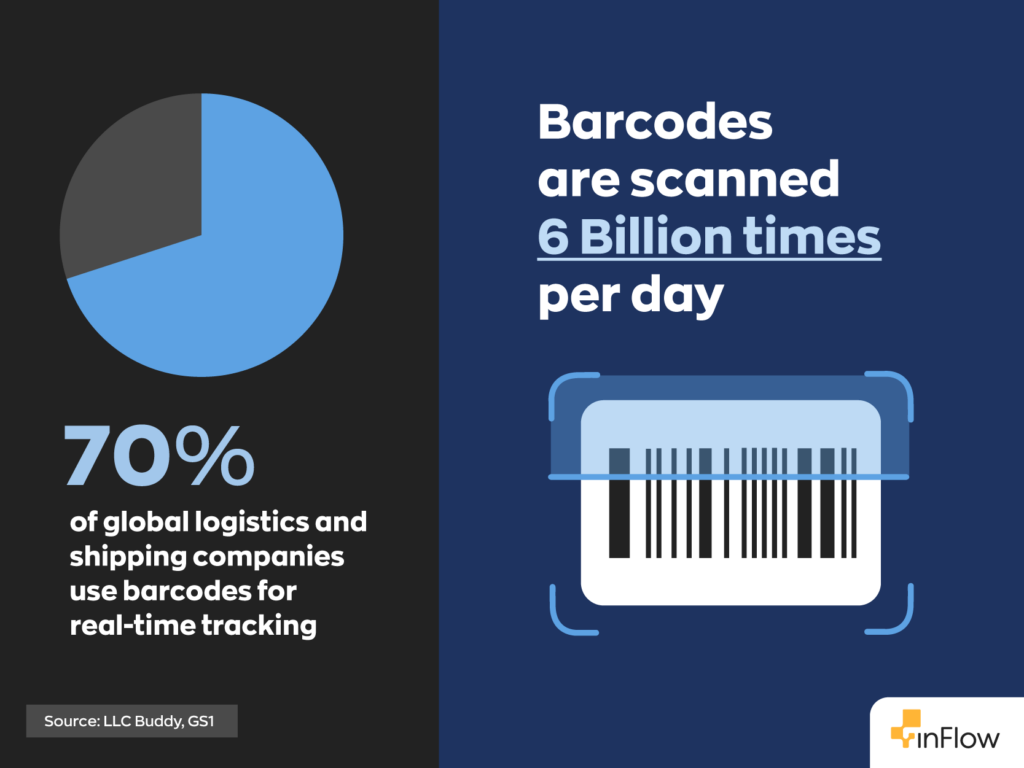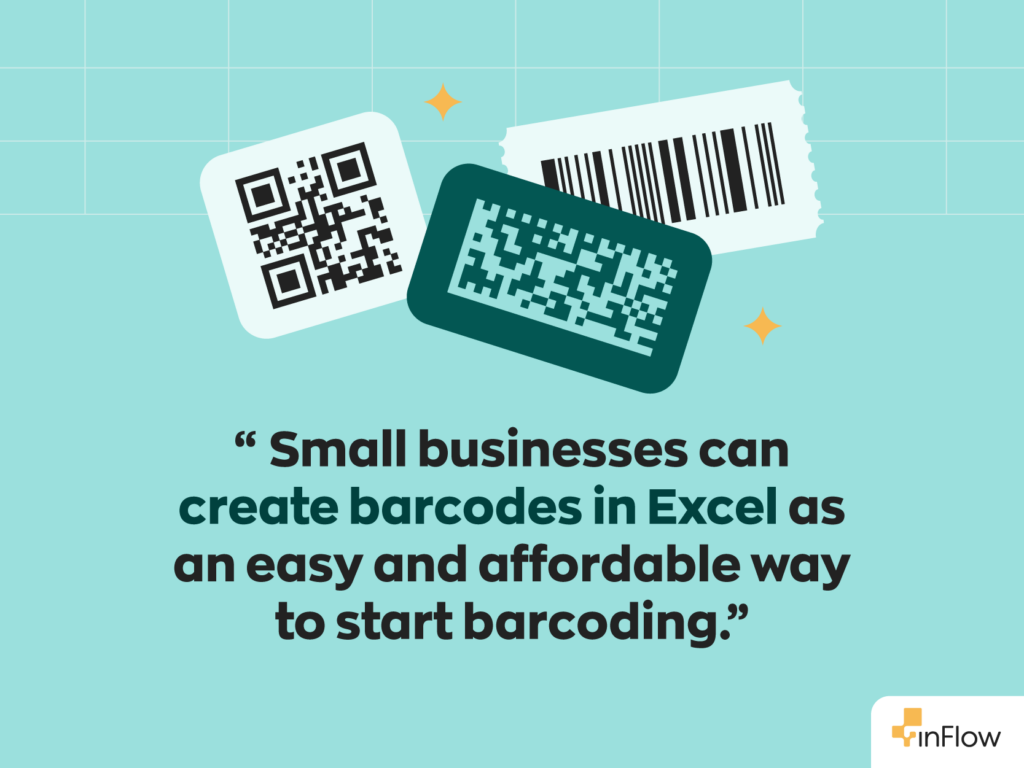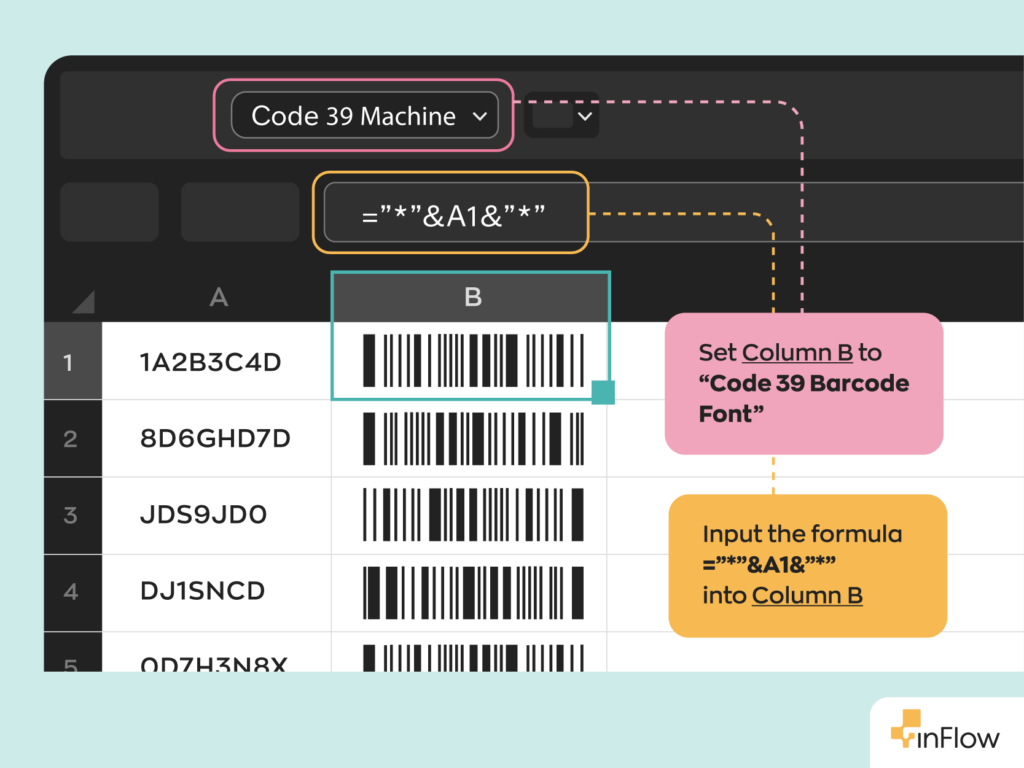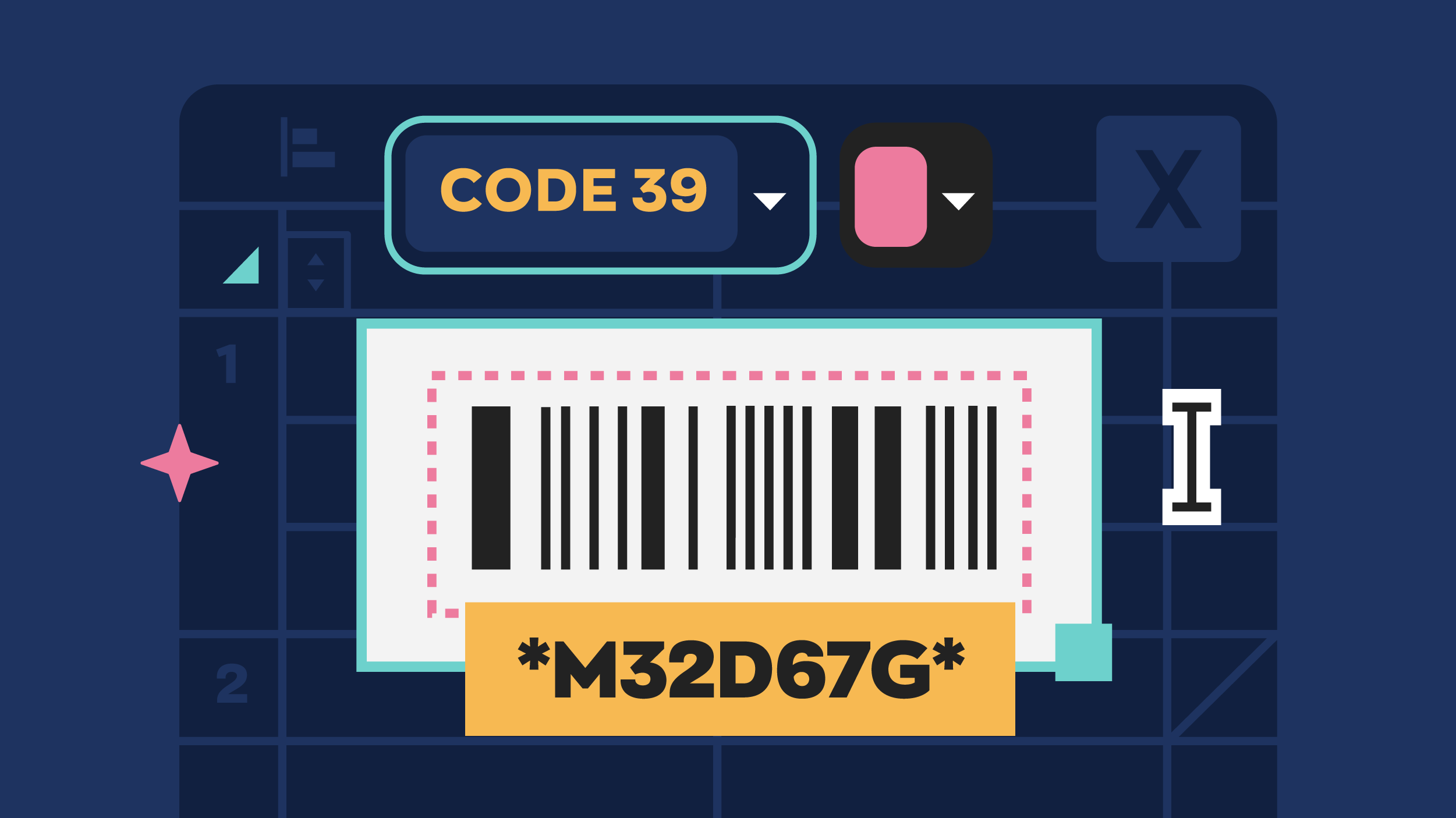Key takeaways
- Small businesses can create barcodes in Excel using a barcode font such as Code 39 to avoid additional software costs.
- Barcodes enhance operational efficiency in many ways, like tracking inventory, organizing shelves, labeling documents, and managing pallets or containers.
- Implementing barcodes doesn’t require technical know-how and has minimal to no start-up costs.
- Barcodes reduce human error, speed up processes, and improve customer satisfaction.
- While creating barcodes in Excel is a budget-friendly solution, it has limitations compared to specialized software like inFlow, which offers advanced barcoding and inventory management features.
It’s no secret around here how much we love barcodes. Few things provide the same amount of value and function when it comes to managing inventory. In addition to tracking product flow, barcodes are great for a myriad of other applications. For instance, you can use them for asset tracking, barcoding shelves, documents, and warehouse pallets or containers.
If you’re having an inventory-related issue, barcodes may help alleviate it. Small businesses, however, may find implementing them daunting. They require some know-how and a bit of extra hardware, but the truth is that just about anyone can implement barcodes at little to no additional cost.
For example, many small businesses create barcodes in Excel when they’re just starting out. You read that right– Excel. Today, we’ll be going over how to create barcodes in Excel and why it might make sense for your business.
Why are barcodes so important?
First things first, though: why? If we haven’t made that abundantly clear by now, the answer is simple: barcodes are incredibly useful.

For example, you can place a barcode on a warehouse shelf and code it to carry information for every product on that shelf. This can help employees locate products more quickly and increase customer satisfaction by reducing customer lead time.
You can also use QR codes on documents to quickly link to valuable resources and information. This could significantly increase the efficiency of your shipping and receiving process, saving your employees time.
Another popular use case is LPN barcodes. These barcodes are placed on pallets, shipping containers, and other warehouse moveables and are integral to managing inventory in large, busy warehouses.
In short, barcodes have many different uses. Their use cases are really only limited by your imagination.
How barcodes in Excel work
Not all barcodes are the same. For example, a QR code is a type of barcode, but it’s distinctly different from the black-and-white stripes you see in stores. We refer to different barcode formats as barcode symbologies. Some of these symbologies are easily accessible through barcode fonts, and these fonts are how you create barcodes in Excel.
It’s as simple as installing your barcode font and then typing it in Excel like any other font. From there, you can create barcodes using alphanumeric characters.

Why create barcodes in Excel?
Strange as it may sound, there’s a few reasons to create barcodes in Excel. For starters, it’s fairly easy and accessible to just about anyone. Businesses tend to use Excel for one thing or another, so it’s really just expanding its use case.
Investing in a new system or software is going to cost money. There’s no way around it. However, if you create barcodes in Excel, software you’ve already bought and paid for, you save on purchasing something new. This means you can start to get the benefits of barcodes at no added costs to your business.
How to generate barcodes in Excel
First, you’ll need Excel (duh).
Next, you’ll need a barcode font. For this guide, we’ll use the Code 39 barcode font. This font initially only had 39 characters, hence the name. However, it has since expanded to contain up to 43 individual characters and is widely used for internal inventory management. We created our own free Code 39 barcode font, which you can download below.
<div style="text-align: center;"><div style="text-align: center; display: inline-flex; flex-direction: column;"><a class="inflow-button" href="https://www.getdrip.com/forms/381769907/submissions/new" data-drip-show-form="381769907">Get the inFlow Code 39 font</a><span class="disclaimer">You are minutes away from typing out barcodes</span></div></div>Installing and using the barcode font
Once you’ve downloaded the font, you’ll find two TTF files: machine-readable and human-and-machine-readable. If you want the characters to appear below the barcode when you type it out, you’ll want to download the human-and-machine-readable. Otherwise, you can download the machine-readable version.
Installing and using the barcode fonts works like any other font. Once installed, you simply select the font from the list of available fonts, and like magic, your keystrokes will now generate barcodes.
One thing to keep in mind when generating barcodes is that for a scanner to read them, you’ll need to start and end each code with an asterisk (*). These symbols are a way of telling the scanner when to start and stop reading the code. So, for example, if you want to create a barcode for M32D67G, you would need to type *M32D67G*.

Setting up your barcode generator in Excel
Now that we have our barcode font ready, it’s time to create a spreadsheet in Excel that will act as our barcode generator. We’ll only need two columns: columns A and B. We’ll use column A to type in the characters of our barcode, and column B will be the cell that will generate the barcodes. The setup process looks like this:
- Start by formatting column A so that it leaves numbers as plain text rather than equations or scientific notation. To do this, right-click column A and select “Format Cells”.
- When the context menu appears, select the “Number” tab.
- In the “Category” column, select “Number” and click “OK”.
- To automate the process of putting asterisks on both sides of our text, we can enter the following formula into column B: =”*”&A1&”*”
- Once you input the formula, apply it to the entire column. You can do this by selecting the relevant cell and then dragging down from the bottom right of said cell.
- To finish your barcode generator, select column B and change the font for the entire column to the barcode font you installed.
Important: We assume you’re also using columns A and B, but you can use any of them. You’ll need to adjust the formula, but that’s simple. For C1, replace A1 in the formula, F4 for F4, and so on.
Creating your barcodes in Excel
Now that you have the spreadsheet set up, things are pretty simple. Whatever you type in column A should appear in column B as a barcode. And since we set the formula in column B to include the asterisks, we don’t need to worry about those in our codes.
And that’s it! Now, you have a barcode generator in Excel. What codes you use for your products is really up to you. You may want to use random numbers and letters or build in some sort of naming convention. The important thing is that you connect those codes to your products in whatever system you’re using to track your inventory.

What to do after you’ve generated your barcodes
Generating barcodes in Excel is great, but now what? Once you have your barcodes ready, you can print them out and attach them to your inventory. There are several options when it comes to barcode label printers, but if money is an issue, a standard office printer would work just fine.
The same goes for barcode scanners. While there are a number of options depending on your use case, the camera on a smartphone can also function as a barcode scanner. How the scanner functions will depend on which software you use with your barcodes. For example, if your inventory sheet is in Excel, a scanner could populate cells simply by scanning a barcode.
You can use the same function to search for a barcode in your Excel sheet. Just hit Ctrl + F to bring up the find menu and scan your barcode. It should populate into the text line, and from there, you can quickly look up the inventory connected to that barcode.
How inFlow’s built-in barcoding system can help
Now that you know how to create barcodes in Excel, you can start to use them in your business. Keep in mind, though, that this isn’t a perfect solution. It gets the job done, but there are some inherent limits to using Excel as a barcode generator.
It’s also worth mentioning that if you’re using Excel to generate barcodes, you’re also using it to track your inventory. While Excel is certainly an option for managing your inventory, when it comes to getting the most out of barcodes, it falls short.
Software solutions like inFlow offer inventory management with built-in barcoding functionality. Our software allows you to create detailed product listings that include all the information about your inventory, including pictures. We enable you to generate barcodes for your products and design custom barcode labels with our built-in label designer.
With inFlow, you get more than just a barcode generator. You get a full-fledged inventory management system at an affordable price.





0 Comments